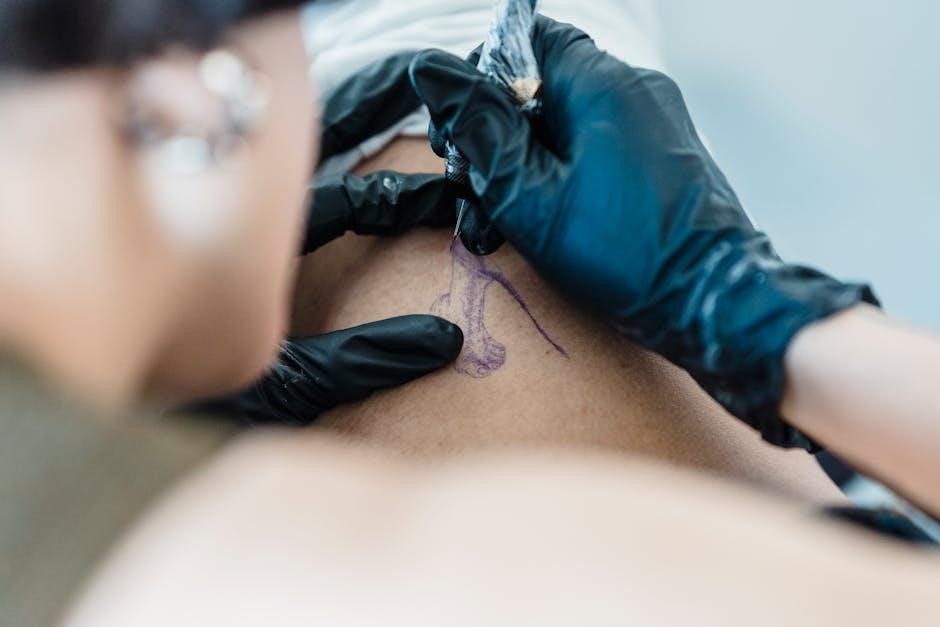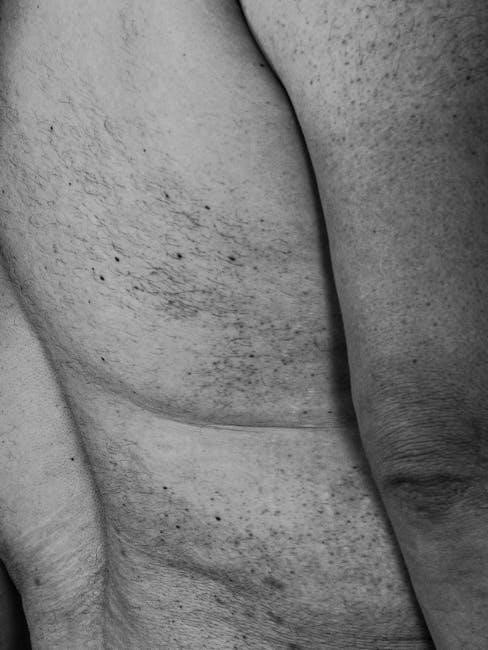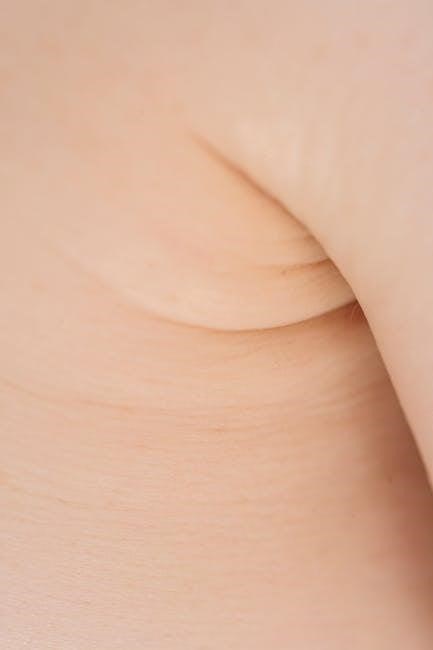Understanding human anatomy is essential for artists to create realistic and expressive forms. It involves studying proportions, bone structure, and muscle placement to accurately depict the body. Mastering anatomy allows artists to capture the nuances of movement and emotion, transforming sketches into lifelike representations. This foundation is crucial for drawing the human figure with precision and artistry.
1.1 Importance of Anatomy in Art
Understanding human anatomy is crucial for artists to create realistic and believable depictions of the body. It provides the foundation for accurate proportions, movement, and expression. Knowledge of anatomy enables artists to convey emotion and depth, making their work more engaging. Without anatomy, artworks may lack precision and authenticity. It is a cornerstone of art education, helping artists master form, structure, and the subtleties of the human figure.
1.2 Key Concepts for Beginners
For artists starting to study anatomy, basic proportions and structure are essential. Begin with the eight-head height rule, dividing the body into manageable segments. Understand the skeletal system as the framework, focusing on major bones like the skull, spine, and limbs. Learn to identify muscle groups, such as the deltoids, biceps, and quadriceps, which define form and movement. Practice gesture drawing to capture posture and movement. Start with simple exercises, like sketching individual body parts, to build confidence and accuracy.
Understanding Proportions of the Human Body
The human body follows a standardized ratio, with the head, torso, and limbs proportionally divided. Proportions are crucial for creating balanced and realistic figures in art. Measurements like the 3:3:1 ratio for head, torso, and legs guide artists in sketching accurately; Understanding these ratios helps in maintaining harmony and realism in drawings.
2.1 Standard Measurements and Ratios
Standard measurements and ratios are foundational for accurate human anatomy drawing. The average adult body follows the 8-head ratio, where total height equals 8 head lengths. This ratio helps maintain proportion in art. Key measurements include the waist width at 2 heads and arm span at 3 heads across. These ratios vary slightly among individuals but provide a consistent framework for drawing balanced figures. Understanding these standards ensures harmony and realism in artistic representations of the human form.
2.2 Body Segmentation and Alignment
Understanding body segmentation and alignment is crucial for drawing the human form accurately. The body can be divided into key segments: head, torso, arms, and legs. Proper alignment ensures balance and natural posture. Landmarks like the spine, pelvis, and shoulder line guide the artist. Accurate segmentation and alignment help in capturing the figure’s proportions and movement, enhancing the overall realism and harmony in the drawing. This foundation is vital for creating dynamic and lifelike poses.

The Skeletal System in Detail
The skeletal system forms the body’s framework. It includes 206 bones, with the skull, spine, ribcage, arms, legs, and pelvis being key areas. Understanding bone structure aids in creating accurate, dynamic drawings.
3.1 Structure of the Skull and Spine
The skull consists of the cranium and facial bones, providing protection for the brain and sensory organs. The spine, comprising cervical, thoracic, lumbar, sacral, and coccygeal vertebrae, offers flexibility and structural support. Understanding these bones’ shapes and alignments is crucial for accurately drawing the head, neck, and upper body. Artists should study how the skull’s proportions and the spine’s curvature influence posture and movement in their work.
3.2 Limbs and Joints: Bones and Connections
The human limbs are composed of long bones, such as the femur and humerus, which provide structural support. Joints, like the shoulder and knee, connect these bones, enabling movement. Understanding the alignment and proportions of limb bones and joints is vital for drawing realistic arms and legs. Artists should study how these connections allow for flexibility and stability, ensuring accurate depictions of poses and gestures in their work. This knowledge enhances the realism of human figures in art.
3.3 Ribcage and Pelvic Anatomy
The ribcage, comprising the sternum, ribs, and thoracic spine, protects vital organs like the heart and lungs. The pelvis, formed by the ilium, ischium, and pubis, supports the spinal column and limbs. Understanding the ribcage’s curvature and the pelvis’s wide structure is crucial for accurately drawing the torso and lower body. Artists should study how these bones interact to maintain posture and facilitate movement, ensuring realistic depictions of the human form in various poses and perspectives.
The Muscular System for Drawings
The muscular system consists of major groups like the deltoids, biceps, and quadriceps. Understanding muscle locations and functions is key for artists to depict realistic movement and body shape. Surface anatomy reveals how muscles create contours, aiding in accurate figure drawing. This knowledge enhances the ability to capture dynamic poses and natural forms in art.
4.1 Major Muscle Groups: Location and Function
The human body contains over 600 muscles, but artists focus on major groups like the deltoids (shoulders), trapezius (upper back), and rhomboids (mid-back). The biceps and triceps control arm flexion and extension, while the pectorals shape the chest. The abdominals stabilize the core, and the quadriceps and hamstrings enable leg movement. Understanding these muscles’ locations and functions helps artists depict realistic poses and body dynamics accurately in their work.
4.2 How Muscles Affect Body Shape and Movement
Muscles define body contours and enable movement through contraction and relaxation. Their structure and placement influence posture, balance, and dynamic poses. For instance, the deltoids shape the shoulders, while the abdominals define the core. Muscles also interact with bones and tendons to facilitate motion, such as flexion, extension, and rotation. Understanding this interplay helps artists accurately depict the human form in various postures, ensuring realistic and expressive drawings.
Surface Anatomy: Visible Landmarks
Surface anatomy focuses on visible features like the clavicle, wrist creases, and knee caps, which guide proportions and accuracy in drawing. Understanding these landmarks ensures realistic depictions of the human form, aiding artists in capturing the body’s structure and movement effectively.
5.1 Identifying Key Features for Accurate Drawings
Accurate drawings require identifying key surface landmarks, such as the clavicle, wrist creases, and kneecaps. These features help maintain proper proportions and symmetry. Understanding these visible markers ensures that the body’s structure and movement are captured realistically. Artists often use these landmarks to place joints and muscles correctly, avoiding common errors like misplacement or distortion. Mastering surface anatomy enhances the credibility and aesthetic appeal of artistic depictions of the human form, making it essential for detailed and lifelike sketches.
5.2 Understanding Fat and Soft Tissue Distribution
Fat and soft tissue distribution significantly influence the body’s shape and appearance. These tissues create curves and rounded forms, such as in the abdomen, thighs, and buttocks. Understanding their placement helps artists capture the body’s natural contours. Properly depicting these areas ensures realistic and visually appealing drawings. Soft tissue distribution also affects how light interacts with the body, making it crucial for shading and texture techniques in artistic representations.
Drawing the Human Face
Drawing the human face requires precision in capturing proportions, symmetry, and expressions. Mastering facial anatomy involves detailing eyes, nose, mouth, and skin textures for realistic portrayals. Practice and observation are key to achieving lifelike results, ensuring each feature aligns harmoniously to convey emotion and character accurately in your artwork.
6.1 Proportions and Symmetry of the Face
Accurate proportions and symmetry are vital for drawing realistic faces. The average face measures 1:1:0.5 for forehead, nose, and chin lengths. Eyes are spaced one eye-width apart, centered horizontally. The nose aligns with the eyes’ inner corners, and the mouth sits halfway between nose and chin. Symmetry involves balancing both sides of the face. Guidelines can help artists maintain proportion and alignment. Mastering these measurements ensures a natural, harmonious appearance in portraits, enhancing overall realism and appeal.
6.2 Expressions and Facial Anatomy
Facial expressions are shaped by the interaction of muscles and bones. The zygomaticus major muscle controls smiles, while the orbicularis oculi governs eye movements. Understanding these elements helps artists capture emotions like joy, sadness, or surprise. Key features include eyebrow angles, lip curvature, and eye openness. Mastering facial anatomy allows artists to convey complex emotions accurately, enhancing the emotional impact of their work. Attention to these details brings depth and realism to portrait drawings.

Anatomy of Hands and Feet
The human hand and foot are intricate, with complex bone structures and joints. Featuring 27 bones in the hand and 26 in the foot, their flexibility and movement are essential for realistic depictions. Understanding their arches and tendons aids in accurate artistic representation.
7.1 Detailed Structure of Hands and Fingers
The human hand contains 27 bones, divided into carpals, metacarpals, and phalanges. Each finger has three phalanges, while the thumb has two, enabling precise movement. The structure of the hand allows for flexion, extension, and opposition, with tendons and ligaments facilitating motion. Artists should note the varying lengths and proportions of fingers, as well as the natural curves and joints, to accurately depict hands in drawings. Attention to these details enhances realism and expression in artwork.
The Full Human Figure: Standing and Poses
Depicting the full human figure requires understanding balance, posture, and weight distribution. Artists should study how poses convey emotion and movement, ensuring natural alignment and proportions for authenticity in their work, making the figure look dynamic and lifelike, capturing the essence of the human form in various stances and movements with precision and artistry, enhancing the overall visual impact of the drawing.
8.1 Capturing Balance and Posture
Capturing balance and posture in the human figure is vital for creating realistic and believable drawings. Balance refers to the distribution of weight, ensuring the figure appears stable. Posture involves the alignment of the spine and limbs, reflecting natural or unnatural stances. Artists must observe how the body shifts weight, tilts, or relaxes to convey movement and tension. Accurate portrayal of posture enhances the believability of the figure, making it essential for dynamic and lifelike compositions in art.
8.2 Dynamic Poses and Movement
Drawing dynamic poses and movement requires capturing the energy and flow of the human body in action. Artists must observe how muscles tense, lines curve, and weight shifts. Movement can be implied through expressive lines, pose angles, and shadow placement. Understanding how the body transitions between stillness and motion is key to creating dynamic compositions. Practice sketching figures in various active poses to master the illusion of movement and energy in your art.

Tips for Drawing Anatomy Accurately
Observe proportions, use reference images, and study muscle and bone structure to ensure accuracy. Practice sketching from life or photographs to refine your technique and attention to detail.
9.1 Using Reference Images Effectively
Reference images are vital for accuracy in anatomy drawing. Use high-quality photos or anatomical illustrations to observe details like muscle structure, bone placement, and body proportions. Study the shapes and contours to ensure consistency in your work. Compare your sketches with references to identify and correct errors. Regularly practicing with references helps develop a deeper understanding of human anatomy, leading to more precise and realistic drawings over time.
9.2 Shading and Texture Techniques
Shading and texture are crucial for adding depth and realism to anatomy drawings. Use techniques like hatching and cross-hatching to create dimension and volume. Pay attention to light sources to accurately depict shadows and highlights. Texture can differentiate between smooth skin, rough bone, or muscle fibers. Experiment with tools like charcoal or digital brushes to achieve varied effects. Practice observing and replicating textures to enhance the lifelike quality of your anatomical art, ensuring a professional finish.
9.3 Common Mistakes to Avoid
When drawing anatomy, avoid common mistakes like incorrect proportions, ignoring alignment, or overdetailing. Proper ratios and structure are vital for realistic depictions. Overlooking the relationship between bones and muscles can lead to unnatural forms. Misjudging perspectives and light sources is another pitfall. Additionally, neglecting to practice regularly hinders progress. Stay observant and patient, as anatomy drawing requires precision and dedication to master accurately and confidently.

Tools and Materials for Anatomy Drawing
Graphite pencils, erasers, and sketchbooks are essentials. Digital tools like graphics tablets and software enhance precision. Reference images and good lighting aid accuracy in your work.
10.1 Best Drawing Tools for Detail Work
For detailed anatomy drawings, use graphite pencils (HB, 2B, 4B, 6B) for varying line weights. A sharpener ensures precision, while erasers (kneaded, white vinegar) correct mistakes. Blending stumps and tortillon smooth shading. A sketchbook with 80-100 gsm paper is ideal. Digital tools like graphics tablets and styluses offer accuracy for intricate details. These tools help artists achieve realism and refine their technique effectively in anatomy studies.
10.2 Digital Tools for Anatomy Sketching
Digital tools enhance anatomy sketching with precision and flexibility. Procreate and Adobe Photoshop offer powerful brush engines for detailed work. Autodesk Sketchbook mimics traditional drawing experiences. Graphics tablets like Wacom and XP-Pen provide tactile control. Clip Studio Paint is ideal for comic and illustrative anatomy. These tools allow for layering, undoing mistakes, and refining details effortlessly. They are invaluable for artists aiming to master human anatomy with both traditional and modern techniques.
Recommended Resources and Tutorials
Explore anatomy drawing with resources like Gray’s Anatomy and Proko tutorials. Websites like New Masters Academy and ArtStation offer courses and reference materials for artists.
11.1 Best Anatomy Drawing Books and PDFs
For artists, Gray’s Anatomy is a timeless resource, offering detailed illustrations of the human body. “Human Anatomy for Artists” by Eliot Goldfinger provides in-depth insights. “Complete Guide to Life Drawing” by Gottfried Bammes is another excellent choice. PDFs like “Anatomy for Artists” and “Figure Drawing Fundamentals” are widely available online. Websites such as Scribd and ResearchGate often host free anatomy PDFs, making learning accessible for all skill levels.
11.2 Online Courses and Video Tutorials
Online platforms like Udemy, Skillshare, and Coursera offer comprehensive anatomy courses tailored for artists. Websites such as Proko and New Masters Academy provide detailed video tutorials. Courses like “Anatomy for Artists” and “Figure Drawing Fundamentals” cover essential topics. YouTube channels like Art Camp and Draw with Jazza also offer free lessons. These resources include live demonstrations, step-by-step guides, and structured lessons to master human anatomy drawing effectively. They cater to both beginners and advanced artists, ensuring skill improvement through practice.

Practice Exercises for Mastery
Gesture drawing and contour studies are excellent for refining skills. Practice daily by sketching from reference images or life. Focus on proportions, form, and detail to improve accuracy and confidence.
12.1 Daily Sketching Routine
A consistent daily sketching routine builds discipline and enhances observational skills. Dedicate 15-30 minutes to practice gesture drawing, contour studies, and detailed anatomy sketches. Start with quick poses to capture movement, then focus on specific body parts like hands or facial features. Use reference images or life models for accuracy. Regular practice strengthens your ability to render proportions, muscle structure, and fluid motion, leading to mastery of human anatomy drawing.
12.2 Breakdown of Complex Poses
Breaking down complex poses involves simplifying the figure into manageable parts. Start by identifying the overall movement and weight distribution. Use basic shapes to sketch the torso, limbs, and head. Focus on capturing the flow of the pose rather than details. Pay attention to key anatomical landmarks like joint alignment and muscle groups. Practice subdividing the body into sections, ensuring balance and proportion. This method helps in rendering dynamic poses accurately and confidently.
Mastering human anatomy empowers artists to create authentic, expressive works. Continuous practice, reference study, and dedication refine skills, fostering artistic growth and confidence in capturing the human form accurately.
13.1 Final Thoughts on Anatomy Drawing
Mastering anatomy is a lifelong journey, requiring patience and dedication. Artists should embrace continuous learning, refining their skills through practice and study. Understanding the human form enhances creativity and precision, allowing for more expressive and realistic art. By staying curious and persistent, artists can unlock new levels of detail and emotion in their work, ensuring growth and mastery in anatomy drawing.
13.2 Encouragement for Continuous Learning
Continuous learning is key to mastering anatomy drawing. Embrace challenges and view each sketch as an opportunity to grow. Dedication and persistence will refine your skills over time. Celebrate progress, no matter how small, and stay curious about the intricacies of the human form. Remember, anatomy is a lifelong journey, and every effort brings you closer to creating art that captivates and inspires. Keep exploring, practicing, and pushing your creative boundaries.